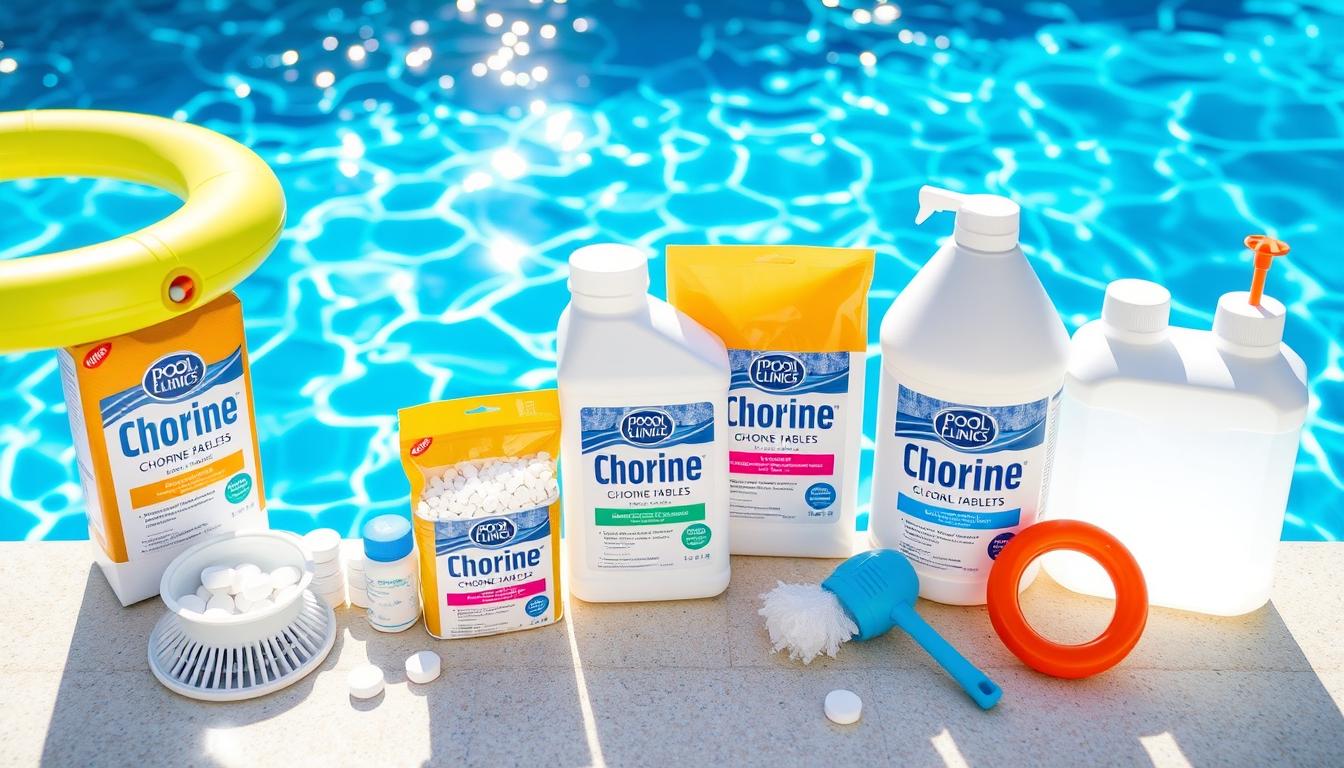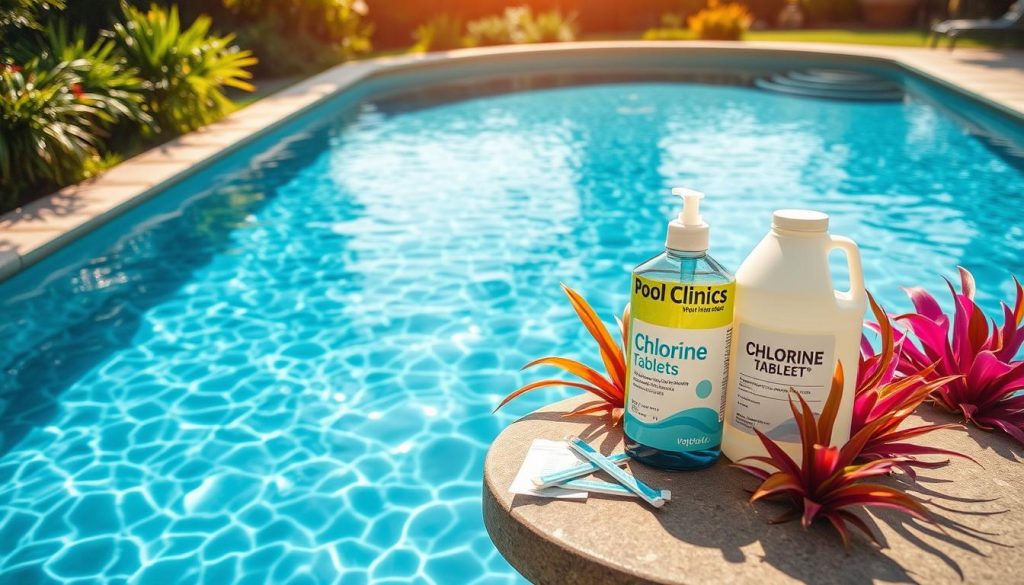
Maintaining clean pool water is crucial for safe swimming. Chlorine plays a key role in pool sanitation. This guide explores various chlorine types for pools.
We’ll discuss different forms of chlorine and their benefits. You’ll learn how to pick the right one for your pool.
Pool owners need to understand chlorine types for proper maintenance. We’ll cover liquid chlorine, tablets, granules, and salt water systems. This info will help you make the best choice for your pool.
Key Takeaways:
- Chlorine is the most popular pool sanitizer due to its effectiveness, affordability, and availability.
- The three main types of chlorine for pools are liquid, tablet, and granule.
- Chlorine can be categorized as stabilized (contains cyanuric acid) or unstabilized (requires separate CYA addition).
- Different forms of chlorine have varying strengths, ranging from 10-12% for liquid chlorine to 90%+ for trichlor tablets.
- Salt water chlorine generators (SWGs) convert salt into chlorine for pool sanitation, but involve a high initial cost.
Understanding the Different Forms of Chlorine for Pool Sanitation
Chlorine is the top choice for keeping pools clean and healthy. Different types of chlorine exist, each with unique properties. Let’s explore stabilized and unstabilized chlorine, as well as liquid, tablet, and granular forms.
Understanding these chlorine types helps pool owners make smart choices. We’ll examine which option works best for specific pool needs.

Stabilized vs. Unstabilized Chlorine
Stabilized chlorine contains cyanuric acid, which protects it from UV rays. This type is perfect for outdoor pools, lasting longer in sunlight.
Unstabilized chlorine lacks cyanuric acid and breaks down faster in UV light. It’s better for indoor pools or shock treatments in outdoor ones.
Liquid, Tablet, and Granular Chlorine
Chlorine comes in three main forms: liquid, tablet, and granular. Each has its own benefits:
- Liquid chlorine acts fast to raise pool chlorine levels. It has a short shelf life and needs frequent application.
- Chlorine tablets dissolve slowly, releasing chlorine steadily. They’re easy to use and last longer than liquid chlorine.
- Granular chlorine dissolves quickly and works well for shock treatments. It lasts longer than liquid but not as long as tablets.
| Chlorine Form | pH Level | Available Chlorine | Shelf Life | Online Availability |
|---|---|---|---|---|
| Liquid Chlorine | Around 13 | 10–12% | 4–6 weeks | Not available |
| Chlorine Tablets | 2.8–3.0 | 90% | Years | Available |
The Importance of Balanced Pool Water Chemistry
Balanced pool water chemistry is vital for effective sanitizing and pool health. pH, alkalinity, and calcium hardness affect how well chlorine works.
The ideal ranges for these factors are:
- pH: 7.2 to 7.8
- Alkalinity: 80 to 120 ppm
Test and adjust these levels at least twice a week. This creates the best environment for chlorine to keep pools clean and safe.
Maintaining balanced pool water chemistry is not only essential for the effectiveness of chlorine but also for the comfort and safety of swimmers. Proper pH, alkalinity, and calcium hardness levels help prevent skin and eye irritation, as well as damage to the pool’s surfaces and equipment.
Exploring the Common Types of Chlorine Used in Pools
Chlorine is crucial for keeping swimming pools clean and safe. It kills harmful bacteria and microorganisms in pools and Jacuzzis. Let’s look at the various types of chlorine used in pool maintenance.
Sodium Hypochlorite (Liquid Chlorine or Bleach)
Sodium hypochlorite is an unstabilized form of pool sanitation. It’s the cheapest option among chlorine types. However, it burns off quickly, needing more frequent application.
Calcium Hypochlorite (Cal-Hypo)
Calcium hypochlorite is a fast-acting, unstabilized sanitizer in powder form. It’s often used for shock treatments to raise chlorine levels quickly. Cal-hypo fights algae growth and keeps water clear.
Like sodium hypochlorite, it dissipates fast and needs regular application.
Trichlor (Chlorine Tablets)
Trichlor tablets are a stabilized sanitizer that dissolves slowly in pool water. This makes them convenient for pool owners. They need less frequent application than unstabilized chlorine forms.
Trichlor tablets go in floating dispensers or automatic feeders. This allows steady chlorine release into the pool water over time.
Dichlor (Granular Chlorine)
Dichlor is a fast-acting, stabilized sanitizer in granular form. It dissolves quickly in pool water. Dichlor is used for shock treatments and maintaining consistent chlorine levels.
Its granular form makes it easy to measure and apply as needed.
Salt Water Chlorine Generators (SWGs)
Salt water chlorine generators offer a different approach to pool sanitation. They convert salt in pool water into chlorine through electrolysis. This eliminates manual chlorine addition.
SWGs require initial equipment investment. However, they provide an easy way to maintain proper chlorine levels.
| Type of Chlorine | Form | Stabilized | Dissolves | Application |
|---|---|---|---|---|
| Sodium Hypochlorite | Liquid | No | Quickly | Frequent |
| Calcium Hypochlorite | Powder | No | Quickly | Frequent |
| Trichlor | Tablets | Yes | Slowly | Less Frequent |
| Dichlor | Granules | Yes | Quickly | As Needed |
| Salt Water Chlorine Generators | N/A | N/A | Continuous | Automated |
Knowing these chlorine types helps us make smart choices for our pools. We can pick based on our needs, budget, and maintenance preferences. The goal is always a clean, safe pool for everyone to enjoy.
What Kind of Chlorine is Used in Pools: A Comparative Analysis
Pool owners have various chlorine options to choose from. Liquid chlorine acts fast and is budget-friendly. However, it doesn’t last long and needs frequent replenishing.
Chlorine tablets dissolve slowly, keeping chlorine levels steady. They’re great for regular upkeep. Granular chlorine dissolves quickly and works well for shock treatments.
Factors to Consider When Choosing Pool Chlorine
Your pool’s size affects chlorine choice. Bigger pools might need liquid chlorine’s quick action. Smaller pools could benefit from chlorine tablets’ convenience.
Some chlorine types can change pH and alkalinity levels. This means you’ll need to check and adjust your pool water more often.
Best Practices for Adding Chlorine to Your Pool
To keep your pool safe, follow these chlorine tips. First, figure out how much chlorine your pool needs. Spread the chlorine evenly throughout the pool.
Let the pool filter run to mix the chlorine well. Always read and follow the instructions on chlorine products. Test your pool water often to keep it balanced.
Understanding chlorine types helps you make smart choices. By following these tips, you’ll keep your pool clean and safe for swimming.







